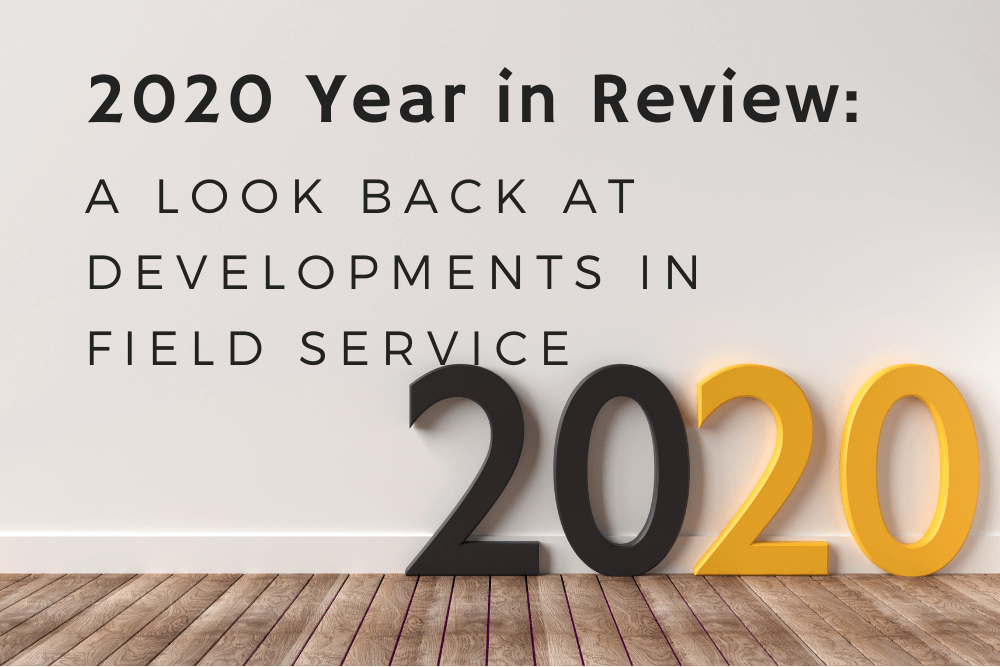
2020 has come to an end. Events that defined the past 12 months are those for the history books, and the year brought about considerable developments and opportunities for field service businesses.
When I wrote the year-in-review blog last year, I stated, “what a year is was,” which, sitting here writing this year’s blog today, the world is a slightly different place.
Like last year, I want you to take a journey back in time with me, to reflect on the positive news, events and happenings that 2020 brought about for field service.
Field Service Management Software Becomes a Requirement
Marked by new ways of getting work done, service businesses were challenged to find solutions to manage teams more effectively remotely. Paper-based processes and single use case software (i.e., only mobile forms or only scheduling) took a turn during the course of the year.
Instead, businesses began looking for a solution that solved all of their challenges in one. Field service management (FSM) software, particularly of the business process automation variety like Field Squared, shifted from a nice to have, or a project for the future, to a requirement.
Industry expert, Bill Pollock, penned the column, The Evolution of the FSM Market – Is Your Organization Keeping Pace, in Field Technologies, stating, “…one out of six companies (17 percent) are running their services operations through a series of manual processes.” Pollock mentioned that was a decrease from the previous year, but it’s pretty incredible.
On our own Field Squared Blog, we also discussed prioritizing field service management software during particularly challenging times. For instance, real-time collaboration from the office to the field is more critical today than ever.
Another timely article from Spencer Gisser of VDC Research set about Key Success Requirements for Field Service Management aided by service software. Gisser broke out the requirements into three distinct categories, of which optimization capabilities rely on technology to truly achieve. Focusing on one category can take the pressure off of needing everything all at once and instead strive for a phased approach.
For 2021, if you are kicking off a project to research and evaluate service software, and are considering building something in-bouse, I recommend reading our blog post, Buy vs Build: Why In-House Built Field Service Management Apps Fail.
AI Gained Momentum in Asset Management
There are very few industries today where artificial intelligence (AI) is engrained. Particularly for service businesses, AI is a stretch goal for some far-off time in the future. Larger, enterprise organizations may have implemented some form of AI or perhaps it is available in one of the cloud platforms already in place.
Over 2020, AI gained momentum. Spurred by changing perceptions, the healthcare field took up the charge. In MobiHealthNews, Dave Muoio covered the use of AI in the patient experience, while cautioning tradeoffs at the current AI maturity level. He took a practical approach in discussing business areas where AI and automation may help healthcare organizations, while cautioning seeing AI as a panacea. Muoio includes examples where AI can be applied, such as messaging. I agree, real-time messaging, combined with field service collaboration solutions, is a key area where healthcare organizations can see an immediate positive impact. I also agree balance is necessary. Knowing when to automate and what to automate is a process, but once a plan is established, taking action is a matter of finding the right mobile healthcare solution.
IDC’s Aly Pinder also weighed in on AI, relating it to technology trends in the manufacturing sector, in his article for Field Service News, The Convergence of AI and Field Service Excellence. For asset management, Pinder mentions AI is a solid solution in preventative maintenance. I expect that to only grow in adoption over the course of 2021.
The future of field service is an interesting topic, and I can’t wait to see what will rise to the top in 2021. By my estimate, AI will play an even larger role outside of enterprise size businesses.




